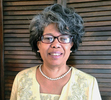Robin R. Foster's Blog, page 2
November 3, 2024
Echoes of the Past: Unveiling Drusilla's Story Through Family Ties

This is how Robyn Rhinehart discovered my blog online: “I was researching my mother's side online and updating my tree after a descendant of George Epps Cannon (my cousin) passed away. I decided to try to research the famous Drusilla again remembering that she supposedly had the last name Tucker. So, I Googled something like "James Tucker plantation South Carolina" and your blog popped up!” She also said, "We are both descendants of Susie Cannon Richard's. Mary Tucker Cannon's daughter."
Finding connections with fellow researchers can be a catalyst for discovery in genealogy. Usually, I help others find their ancestors. When Robyn Rhinehart reached out to me on Facebook, I noticed her familiar name although she spelled her name with a "y." Robyn messaged me: “I'm a descendant of the Tuckers in Union County, SC. My great-great-great-grandmother was Drusilla Tucker from Union Fishdam, SC.” My heart leaped. Could this be the missing piece to the story I had long pursued?
Immediately, I stopped and took notice. Drusilla Chick Sims was a name that had lingered in my research for years, an ancestor whose narrative seemed incomplete. I never thought I would find out about Drusilla Chick Sims. Robyn’s message sparked memories and led me to reexamine my notes. Drusilla had indeed used the name Tucker on the 1880 Census—a discovery that brought new depth to my understanding of her life.

"United States Census, 1880", FamilySearch (https://www.familysearch.org/ark:/61903/1:1:M63M-VQ4), Entry for Cilla Tucker or Drusilla, 1880.
Earlier, the 1870 Census revealed that Drusilla was married to Henry Sims. They lived right next to James Anderson Tucker—a connection that suggested more than coincidence. James was an enslaver.

"United States Census, 1870", FamilySearch (https://www.familysearch.org/ark:/61903/1:1:M8R1-WQ4), Entry for Henry Sims and Scillar Sims (Drusilla), 1870.
James Tucker’s death in 1885 marked a turning point. By then, enslavement had ended two decades prior, but it was in that year that Drusilla was truly free to reunite with her family. The 1900 Census confirmed that she was back with Henry. This chain of records painted a story far more personal than data on a page.
It was divine intervention and Robyn’s words that confirmed Drusilla had more children. “We were always told she was born in Madagascar and brought to the US. Her owner and the father of her children was James Tucker, a planter from SC, but that’s all we know,” she shared.
A timeline of Drusilla’s children during enslavement with one in 1866 further unraveled their intertwined identities (births are one to two years different):
1840: Birth of Elmira Sims (1840–1932), South Carolina.
1844: Birth of Mary J. Tucker Cannon (1844–1938), South Carolina (Robyn's 3rd great grandmother).
1846: Birth of Harriet Tucker Cannon (1846–1941), South Carolina.
1853: Birth of Nathan Sims (1853–1932), South Carolina.
1855: Birth of Martha Sims (1855–1936), South Carolina (Robin's 2nd great grandmother)
1857: Birth of Brooks Sims (1857–), South Carolina.
1860: Birth of Augustus Sims (1860–1941), South Carolina.
1866: Birth of Picket Sims (1866–), later known as Tucker.
The blend of names—Sims, Cannon, Tucker—revealed the legacy of those years. The moment Robyn shared the photo of Drusilla, passed down by her Cousin Marianne, it felt as Heavenly Father had whispered to us.
Yes. That is right. Drusilla moved to New Jersey City where she had Cannon descendants. Our next step is clear: tracking down Drusilla’s original death certificate from New Jersey City, Hudson County. New Jersey, Death Index, 1901-2017 (Ancestry.com).

New Jersey, Death Index, 1901-2017- Ancestry.com: https://www.ancestry.com/family-tree/person/tree/11249450/person/160083922466/facts
The journey continues, and with each step, Drusilla’s story becomes a testament to resilience and the power of rediscovered family ties. We are adding Sims and Cannon to our family trees. Stay tuned as Robyn and I uncover more pieces of this remarkable legacy. You will find out that Drusilla’s has two George Epps.

Children of Drusilla Sims Cannon:

James Anderson Tucker was the enslaver to the children born before 1865 (https://www.ancestry.com/family-tree/person/tree/11249450/person/160083922466/facts).
September 3, 2024
Exploring the Chairs from Enslaved People at Presley Nelms Jr.'s Plantation

Yesterday was a day filled with anticipation and excitement as we eagerly made our way to the Anson County Historical Society to meet with Steve Bailey. The purpose of our visit was to examine the chairs generously donated by Barbara Griffin, which had once belonged to Presley Nelms Jr., my fourth great grandfather. These chairs held a special significance as they were originally placed in the enslaved house (I had ancestors there), carrying with them a profound historical weight and a poignant reminder of a past that we must never forget.

Upon seeing the chairs, a wave of humility washed over me, realizing the stories and experiences that these simple pieces of furniture bore witness to. It was a moment of reflection and reverence, as I stood in the presence of objects that connected us to a time long gone but not to be erased from memory.
Delving into the history of my ancestors, I discovered a fascinating connection to the past. The legacy of my third great grandparents, David and Lucy Nelms, is a testament to resilience and perseverance. Imagining their lives in that place, I couldn't help but feel a sense of awe and admiration.
As I stood next to the chairs that might have once belonged to them, a wave of nostalgia washed over me. Perhaps my second great grandfather, Buck Nelms, sat on one of those very chairs, his presence lingering in the air like a whisper from the past. The thought of tracing my family lineage through these tangible remnants of history filled me with a profound sense of belonging and curiosity. Each chair held a story waiting to be unraveled, connecting me to a time long gone.

Steve Bailey's invitation and the opportunity to view these chairs not only provided a glimpse into the past but also served as a reminder of the importance of preserving and honoring our history. The act of donation by Barbara Griffin further highlighted the significance of community efforts in safeguarding our heritage for future generations to learn from and appreciate.



As I left the Anson County Historical Society that day, I carried with me a newfound sense of gratitude and respect for the individuals and stories that shaped our shared history, reaffirming the importance of acknowledging and commemorating every aspect of our past, no matter how challenging or uncomfortable it may be.
I also was given a few more clues. Steve gave them to me. I have begun again. Last night, I came up with a string of possibilities. Just subscribe by entering your email address at the top of this post.

June 29, 2024
Triumph Over Trials: My Phillis Wheatley Book Award Journey

I am pleased to announce a recent personal achievement that took place earlier this month. I am humbled to have been bestowed with the SDUSMP Phillis Wheatley Book Award in the Historical-Genealogical Research, Nonfiction Category, which was recently received in my mailbox. The book is here: "My Best Genealogy Tips: Finding Formerly Enslaved Ancestors."
The significance of this recognition has deeply resonated with me, and I would like to express why it holds such profound meaning:
During my youth, I selected Phillis Wheatley as the subject of a book report, focusing on her influential work, Poems on Various Subjects, Religious and Moral. The opportunity to portray Phillis Wheatley during the presentation filled me with enthusiasm.
While attending a predominantly white Catholic school, I sought solace and inspiration within the confines of the public library. Guided by a higher power, I dedicated weekends to delving into literature concerning the Protestant Reformation, figures such as Martin Luther, and prominent African American leaders like Book T. Washington, Frederick Douglass, and W. E. B. Du Bois. These readings offered a much-needed counterbalance to my educational experience, a personal pursuit kept discreetly to myself.
Following the independent authoring of several books and getting over the effects of a stroke I encountered in 2016, I began to write again. In 2021, although my sister initially offered to publish my book, “My Best Genealogy Tips: Quick Keys to Research Ancestry,” she ultimately claimed the majority of the proceeds. Despite this setback, a glimmer of hope emerged when my daughter, Adrianne, assumed the role of my publisher. I love everyone, especially those with whom I find do not extend the same love to me. I believe this is what my education taught me.
I am profoundly thankful to The Sons and Daughters of the United States Middle Passage for bestowing this prestigious award upon me. The award now proudly adorns the space beside the book for which it was granted. For those interested in exploring the full array of award-winning books, they can be accessed here.
May 28, 2024
Researching Your Black English Roots - Mrs. Mary Seacole (1805 - 1881)

Here is a bit of inspiration for those of you who find yourself running into a brickwall. Widen your search to include YouTube or university websites. If your ancestor is missing or not show up where you think he or she should, check out surrounding counties or maybe they decided to go to a different country.
Mrs. Mary Seacole had her autobiography, "Wonderful Adventures of Mrs. Seacole in Many Lands" published in London in 1857. She was born free in Kingston, Jamaica to a Creole mother and a white army officer from Scotland. Mrs. Seacole travelled many places before she arrived in London. She volunteered to be a nurse in the Crimean War. She was turned down.

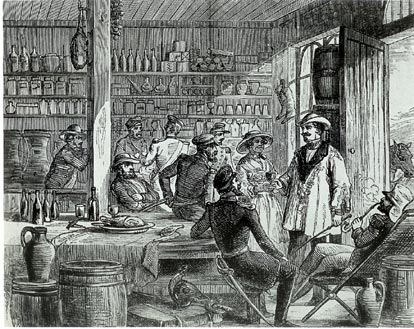
In 1855, she left in a ship with medical supplies. In Crimea, she ran the "British Hotel" near the battlefields, and she was a nurse to soldiers who had been wounded. Mrs. Seacole went out the battlefront and cared for soldiers there.

I love it that Mrs. Mary Seacole wrote her autobiography. I have included it free here: Wonderful Adventures of Mrs. Seacole in Many Lands. Here are different formats for the eBook: Wonderful Adventures of Mrs. Seacole in Many Lands by Mary Seacole (Project Gutenberg). In addition, below is an audiobook:

Wonderful Adventures of Mrs. Seacole in Many Lands by Mary Seacole
A few historic records:
Find A Grave: Mary Jane Grant Seacole (1805 -1881)
2. England & Wales, Civil Registration Death Index, 1837 - 1915 for Mary Seacole

3. 1881 England Census: Mary Seacole

4. Photo of Mary Seacole:

5. 1944 Newspaper Article




Ancestry.com. Daily Gleaner (Kingston, Jamaica) [database on-line]. Provo, UT, USA: Ancestry.com Operations Inc, 2003.
Original data: Daily Gleaner. Kingston, Jamaica. Database created from microfilm copies of the newspaper.
Hopefully, you will appreciate the story of Mrs. Mary Jane Grant Seacole and the use of "My Best Genealogy Tips: Researching Your English Roots," which we used to flesh out historical records on her life. You can purchase "My Best Genealogy Tips: Researching Your English Roots" here: Books2Read - Robin R. Foster.

May 26, 2024
The missing ancestors...By Vincent Alexander Davis

Have you ever started your research and come across that proverbial brick wall where you KNOW an ancestor existed (after all, you're here, right?) but you can't find them save for a few records here and there? Well, that is exactly what I am dealing with now in that I am looking for my great-great grandmother Cora (Sutton) Bracey. The problem is, all trace of her ends after the birth of my great-grandaunt Corrine Bracey. So, where is she?
As genealogical researchers, one of the things we accept is that sometimes, we won't find everyone. It's not right, especially as African-Americans, that our ancestral paths are usually stopped because our ancestors' lives did not matter to a number of people. That said, these lives matter to US. Thus, I won't give up searching for my great-great grandmother.
Cora Sutton was born to Frank and Louisa Sutton (my third great-grandparents) in about 1873 in Hinds County, MS (presumably around Raymond). One thing I can say about Frank & Louisa is that they had a lot of kids and both lived a long time. Also, surprisingly, there was a dearth of information on them both. Now, anyone researching MS records knows how hard it is to find concrete records of your ancestors both before and after slavery, but it is possible. For the longest time, I was able to go by the (mostly accurate) oral history that my late grandmother provided for the Sutton side of her family. Then several years ago, I came across a marriage license which further validated some of the information my grandmother gave me:
Cora Sutton was married to Gus Bracey (my great-great grandfather, in 1891). Check.
Cora was about 18 when she got married (she was actually 19). Check.
Bankston Bracey (my grandmother's granduncle) was Gus's brother. Check.
Note: My grandmother fondly remembered a George Evans (she said they called him Georgie) and his wife Mary Bracey (whom she specifically identified as her father's first cousin), and that Mary's father was named 'Banks'.
The marriage license corroborates all this information.
In fact, we now know that Cora and Gus had at least two children: Clay (my great-grandfather) and Corrine (my great-grandaunt). The problem is that she seems to have disappeared after Corinne's birth. Though I have seen the name Cora (or Corah) Bracey in other records, certain information doesn't line up, so I know those records are not attributable to her.
So then what happened to Cora? Something definitely happened, as Clay and Corrine were both raised by Cora's parents, Frank & Louisa Sutton. Further, I found two other sons of Gus Bracey (Harvey & Louis) whom he raised. Corrine is a bit difficult to track also, but I believe that I was able to track her to Chicago as she got older.As such, to wrap things up, I am appreciative of finds like this marriage record to corroborate the information passed on to me orally. As a professor of Communication Studies, there is nothing we like better than validated information. At the same time, the mystery still remains as to what happened to Cora.
I'll let you know when I find out.
May 23, 2024
Researching Your Black English Roots - Dr Harold Moody (1882-1947)

Just in case you do not know, this is Dr. Harold Moody (1882-1947) born in Kingston, Jamaica and came to London in 1904 where he "studied medicine at Kings College London, graduating top of his class in 1910," The Life of Dr Harold Moody. See the photo of Dr. Harold Moody.
"Despite his clear academic brilliance however, he was unable to gain work as a doctor because of the colour of his skin. He was left with little option but to set up his own practice from his home in 1913. Dr Moody ran his GP surgery from his address in Peckham, London. At a time before the NHS began in 1948, Dr Moody used his medical ability and compassion for others to treat poor children free of charge. He also welcomed into his home those who had been refused lodgings due to the colour of their skin. Through his interactions within the community, he became more and more aware of the racial injustices that others were facing, and he took it upon himself to use his position, wherever he could, to right those wrongs.
In 1931 Dr Moody founded the ‘League of Coloured Peoples’ and as President he worked tirelessly lobbying politicians, the civil service and trade unions seeking to build and strengthen race relations and challenge injustices," The Life of Dr Harold Moody."

Now, I would like to show you how easy it was to get historical records. In the eBook of The Life of Dr Harold Moody, you will see a timeline on page 12 and 13. First, let us take the obituary:

Guess what! Here is another one. It is in Richmond, Virginia:

We could just search all day and find even more of Dr. Harold Moody's death in the obituaries. The death index was at familysearch.org:

If you wanted to see an original death certificate, one suggestion is to go to FindMyPast.com.
We found a 1911 Census in England:

At familysearch.org, they have the index. If you want to see an original, go to FindMyPast.com. Let us take Dr Harold and Olive Tranter Moody's marriage which was in 1912. Here is the marriage index:

If you have a marriage index and you want an original contact: General Register Office.
With this blog post, you can download The Life of Dr Harold Moody for your children or your grandchildren. You can also use the historical records to find your ancestor. Be sure to get this book: "My Best Genealogy Tips: Researching Your English Roots," available at Books2Read - Robin R. Foster.

May 15, 2024
Unlocking the Past: Journey Through ‘My Best Genealogy Tips’ for English Ancestry

That's right! We have been waiting for a loooooong time! The day has finally arrived. Are you excited? So am I! We got three versions of "My Best Genealogy Tips: Researching Your English Roots."
The Kindle eBook is $2.99. Hopefully, you will give a review before you forget: Amazon.com: My Best Genealogy Tips: Researching Your English Roots eBook: Foster, Robin R.: Kindle Store

Amazon.com: My Best Genealogy Tips: Researching Your English Roots eBook: Foster, Robin R.: Kindle Store
2. The paperback is $12.95: My Best Genealogy Tips: Researching Your English Roots: Foster, Robin R: 9798224151240: Amazon.com: Books

3. The hardcover is $25.95: My Best Genealogy Tips: Researching Your English Roots: Foster, Robin R.: 9798325328442: Amazon.com: Books

Welcome, fellow time traveler! As you step into the world of genealogy, prepare to unlock hidden doors and peer through the keyholes of history. Let's go through the chapters.
Chapter 1: Getting Started
Planting Seeds of Curiosity
Begin your quest by dusting off old photo albums and listening to family tales. Learn how to decipher birth certificates, marriage records, and census data. Your journey starts with a single step—a name etched in time.
Chapter 2: Adding to an Online Family Tree
Branching Out Digitally
Explore the power of online family trees. Collaborate with distant cousins and share discoveries. Watch your tree flourish as you connect the dots across continents.
Chapter 3: County Clues: The Impact of Geographical Knowledge
️ Maps, Parishes, and Peculiarities
Dive into county histories and local parishes. Learn what county your ancestor lived in.
Chapter 4: Utilize More Online Resources
Beyond Google: Navigating Genealogy Websites
Ancestry, FamilySearch, Findmypast—your treasure troves await. Learn advanced search techniques and tap into specialized databases. The internet isn’t just a tool; it’s a time machine.
Chapter 5: England Historical Record Types
Parchments and Parish Registers
Decode the cryptic language of old documents. Follow the ink trails of baptisms, marriages, and burials.
Your ancestors’ lives are etched in ink—read between the lines.
Chapter 6: Local Resources
️ Archives, Libraries, and Dusty Attics
Visit local archives—the sanctuaries of secrets. Handle fragile manuscripts and breathe in the scent of history. The librarian winks; the archivist nods. They guard the keys to the past.
Chapter 7: Documentation of Events
Chronicles of Triumphs and Tragedies
Births, deaths, and everything in between. Imagine the joy of a christening and the sorrow of a widow’s black veil. Your ancestors danced at weddings and wept at gravesides. Their stories echo.
Chapter 8: Sharing with Family and Online
From Letters to Social Media
Bridge the generations with tales of resilience. Pass down heirlooms, recipes, and whispered legends. The virtual fireplace crackles as you gather around—the global family reunion.
Chapter 9: Educational Opportunities
Genealogy Courses, Workshops, and Conferences
Enroll in the School of Ancestral Arts. Attend conferences where the air buzzes with shared passion. Get a deeper connection to your roots.
Each chapter holds a unique thread in the tapestry of family history. Your ancestor's beckon. Their footsteps echo in the archives. Grab your magnifying glass, unfurl the parchment, and let the ink-stained pages reveal the saga of your lineage.
Happy sleuthing! ️♀️
May 5, 2024
Exploring the Rich History of Marlboro County, SC at Anson County Historical Society in Wadesboro, NC

That is right. I went to the Anson County Historical Society today to work on my own research. As I was walking inside, Steve Bailey said to me, "Guess who I heard from morning?" It was someone I have been researching for. He mentioned that he had collected lots or resources for Marlboro County, South Carolina. You know where this is going. I was just too excited to pass that up.
When you go to the place your ancestor lived or near it, you experience things you cannot online. I have another experience like that, but I am going to save it and tell you completely about it when I have rung it dry.
Steve immediately got several books from Marlboro County, SC down from the bookshelf. Oh boy! I said to myself, "I am excited."
Marlboro County, SC and Anson County, NC
Marlboro County, located in South Carolina, and Anson County, situated in North Carolina, are neighboring counties that share a border.
Here’s a brief overview of each:
Marlboro County, SC:
Founded in 1785 and named after John Churchill, the 1st Duke of Marlborough.
The county seat is Bennettsville.
The Great Pee Dee River runs through it, and it is home to the Pee Dee Indian Tribe.
Anson County, NC:
Established in 1750 and named for George Anson, Baron Anson.
It has a rich history, originally occupied by the Catawba Siouan tribe.
[image error]
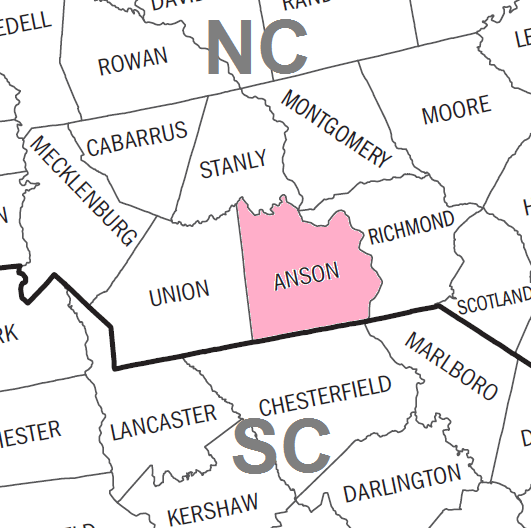
Both counties have a deep historical significance and are part of the broader region known as the Pee Dee, named after the Native American tribe and the river that flows through the area. Make sure you ask if the historical society has books from surrounding counties.
Browsing the books on Marlboro County, SC
The names of my patron's ancestors were in my head. I had not brought anything with me. For two hours Ellis took photos while I looked for names, and Marlboro County cemeteries, churches, land conveyances, Bennettsville cotton mill, and Marlboro County history. I went through almost all of what Steve gave me.
What I would like to do for you now is to tell you what books I had and the types of things I looked for. This is so that if you are ever in this position in a historical society, you will know how to have some success by looking at the same type of books.
The first book that I looked at was "Bennettsville and Marlboro County in Vintage Postcards," by Jerry Thomas Kendall. It was donated to the ACHS by Mrs. Dora on March 20, 2019.

I checked the index, but I did not find any of the people that I was looking for. Perhaps some of you might want the book because of photos inside such as the courthouse. The book is out print. Call the ACHS to find out more.
The second book was "Cemetery Records of Marlboro County, South Carolina," by Elizabeth C. Drake and Jacquelyn M. Rainwater.


I looked up the two surnames that are my patron's ancestors, and I found both surnames. We went to the respective pages they were on, and Ellis took photos of each one. I also had him to take a photo of all the cemeteries. I have not yet determined if any are African American, but if they are not, I can find out if they were the enslaver to his ancestor.
Next, the third book was "A History of Marlboro County, South Carolina," by J. A. W. Thomas. I found the churches and the surnames of my patron's ancestors. Before 1865, the churches the enslaver went to might have the enslaved listed in the church record. I first found church records at Darlington County Historical Commission & Museum. They will be having their Darlington County Museum Grand Opening at 10 am on May 18.


In the back of the book, there was a map of Marlboro County, South Carolina prepared by Capt. J. R. Parker. I love these old maps because I love seeing the property owner's names. The Anson County Historical Society volunteer, Cruse Carpenter, got a copy for me:
[image error]
"The Abstracts of Marlboro District, SC Land Conveyances, Books H1, K, M (1813 - 1827)," by Larry W. Cates, MLIS was the next book I had a chance to look at. I found the surnames of my patron's ancestors, and I found a list of the enslaved with the enslaver who owned them.

I went on to look at "The Bennettsville Cotton Mill," book by Jerry T. Kendall. I identified the names of the people with the same surname of my patron's ancestor living in the same house.

I was pretty excited about this last book called, "Rediscovering the Gulf: Bennettsville's Colored Business District 1876-1976." It had photos, and we found one family photo that had the same surname as my patron. Plus, how great it would be if I determine that the people listed in the index with the same surnames match my patron's ancestor since they are African American.

Here are a few more photos from Saturday:



I took the opportunity to chat with Steve and Cruse Carpenter, a first-year graduate student at Winthrop University in Rock Hill, SC.


February 7, 2024
We Were Here: Enslaved in Cumberland County, North Carolina
 Negroes for Sale, Runaway, Wanted, or Hired Out from Fayetteville or Cumberland County, North Carolina before 1865
Negroes for Sale, Runaway, Wanted, or Hired Out from Fayetteville or Cumberland County, North Carolina before 1865Were there any Fayetteville or Cumberland County, NC enslaved before 1865? That is the question I had on my mind when someone said, "No. There were no slaves in Cumberland County, NC." I have been thinking about this. She had to be wrong. She said this in a meeting with other members. African Americans were in that room.
This has bothered me. I know I need facts with sources. None of my ancestors were enslaved in Cumberland County, NC. My husband, Ellis, had a co-worker who got my book. He has Fayetteville ancestors who were enslaved.
I knew how to search the newspaper. I used Newspaper Titles · DigitalNC. I looked up: Negro, Negroes, Fayetteville in Cumberland County.
This is the results:

Search Results · North Carolina Newspapers ( digitalnc.org )
There were over four hundred pages. Searching before 1830 would have given us even more enslaved. In 1855 part of Cumberland County was divided into Harnett County, so you have to search that Harnett County after 1855 to find more enslaved.
Even though in some cases the name of the enslaved may not be on the newspaper article, but you can search the name of the person who took out the ad. In some cases, the name of the enslaver or administer is in the newspaper article. If you have questions, just email me: robinfoster@genealogyjustask.com. Here are some newspaper articles before 1865 that I found:
1.

2.
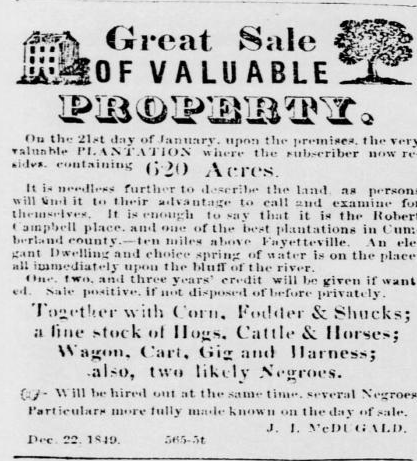
3.

4.
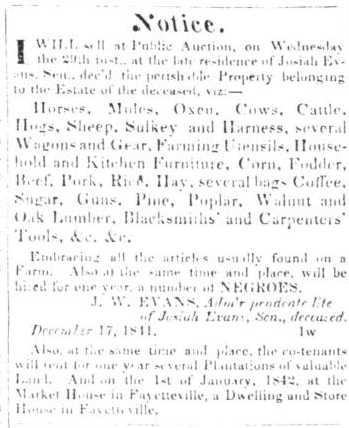
5.
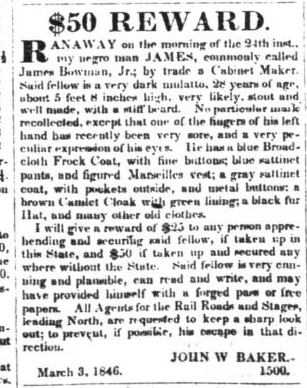
6.
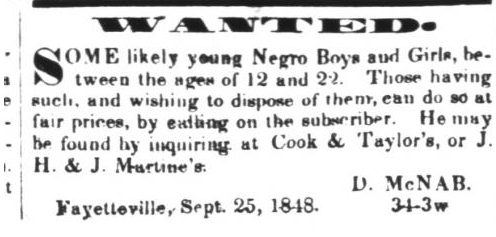
7.

8.
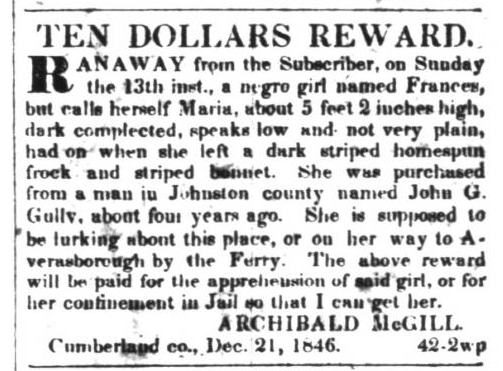
9.

10.
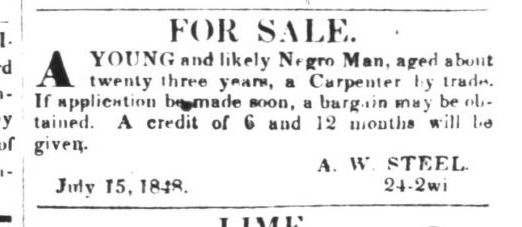
11.

12.

13.

14.

15.

16.
I happened upon a newspaper article about the Fayetteville Arsenal and Armory. The cornerstone of the arsenal was placed on April 19, 1838. Where can you go to learn more about the arsenal? ,NC History Center on the Civil War, Emancipation & Reconstruction.
History of the Fayetteville Arsenal Site is part one of video series commissioned two local university students, Dorien Caldwell from Fayetteville State University and Angel Garcia from UNC Pembroke. If you have ancestors from this area, please contact them to find out if your ancestor could have worked at the arsenal.

Some of you have not purchased my book, My Best Genealogy Tips: Finding Formerly Enslaved Ancestors. It assists you in thinking about where else you could have looked. Let us share with everyone our findings (sources) so that everyone can have the truth.
January 30, 2024
More Ways to Find Your Ancestor’s Parent

Here are five crucial records that you can use to assist in identifying the parent of you ancestor:
Courthouse records
The answer to your genealogical problems could be hidden away among the courthouse records in the area where your ancestor lived. It might be time to take a break from online research to discover what do you have been missing. When you make a trip to the courthouse, you do not want to do it blindly.
You will want to find out as much as you can about what records are available and how they are organized: Visit the online website of the county or parish to see if it provides instructions for researchers or types of records available. Then, contact them to learn more.
Courthouse records provide another alternative to the unavailability of vital records. Some records that can help to identify parental relationships are:
• naturalization
• civil and criminal
• wills and probate
Other records that may provide clues are:
• land and property
• guardianship
• tax
Now, you can find some of these records among the online databases, but I want you to see what I found while researching at the Greenwood County Courthouse in Greenwood, South Carolina.
Using estate records
On this day, I was looking at their probate records between 1895 and 1946. I was browsing through the index book:
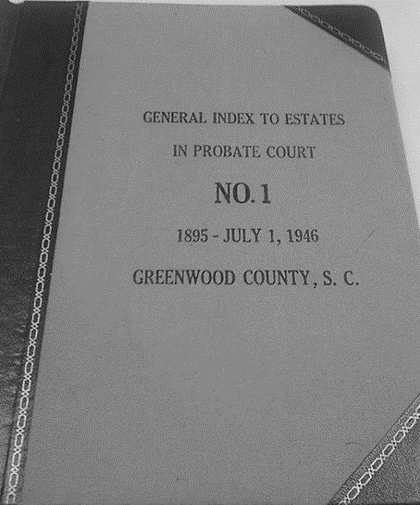
This county was Abbeville County before 1897. I was excited because I had found out they did not move, but now it was Greenwood County. As I browsed through the book, I came across Lewis Johnson:
I first remembered that I had a Lewis Johnson (1865-1909) in my family. He was my great uncle, brother of Lula Johnson Vance. Their parents were Andrew Johnson and Jane Smith Johnson. His wife, Arie Anna Vance Johnson (1865-), was my great aunt. Arie Anna was the child of Beverly Vance and Matilda Dunlap Vance. I loved them because they were all family. I had traced them backwards and forwards. I was not going let one historical record slip by me.
Lewis and Arie Anna were on the Greenwood County, South Carolina 1900 Census:

You can see Arianna, Lewis’ wife. Her name was misspelled. Arie Anna was how she spelled it. I knew Lewis died before 1910. I knew that because he did not show up on the 1910 Census.
Deaths were not recorded in South Carolina at that time. I decided to look up the Greenwood County Estate Packet 64-6 which was Johnson, Lewis.

When I got out the packet, I saw Mrs. Arie Anna Johnson, and the year filed was 1909. This was the right Lewis Johnson. It meant a lot to me. It was the first time someone had left a will. Do you ever think, "We don't have wills in our family." Well, you should check. I was surprised to see the top of the page. Lewis had made this out in Spartanburg County, South Carolina. That reveals another place for me to look.
Lewis willed that all his funeral expenses and just debts should be paid “with the most convenient speed.” He gave Arie Anna Johnson all his estate and property, real and personal. After his wife’s death, all his property would go to his children. They are: Arie Anna Martin, Charles Samuel, Carrie L., Elizabeth, Walter, Henry, Ulyses, Willie Evenor, and Hattie Johnson. Lewis empowered Arie Anna Johnson. It was witnessed on 10 September 1909.


I have a lot to go through here with all the contents of the packet. One thing that I took away this day was the fact that casting your eyes upon the historical documentation on your own family feels much different than looking at an image on microfilm or computer screen.
Granted, not everyone can travel to the places where the records exist, but this is my way of connecting with the people that I never knew in this life - - the people whom I have come to love and feel close to. My reward is feeling their presence and help.
How finding the will led to a deed
Now, I knew that he had property. I decided to look at deeds. That is another misconception. Meaning, do you ever say, "We don't have deeds." Well, guess what? Property not paid off will be listed under mortgages. So, that is two ways to find your ancestor's parent. After I left the Greenwood County Probate Records Office where I had discovered the will, I visited the Clerk of Court down the hall. I knew Arie Anna had been named the executor of his estate, so I figured her name would be among the records.
I started with searching the grantor deed indexes for the Johnson family surname. I discovered Arie Anna's name. The corresponding book (17), page (280), and year (1911) appear on the index.
All the deeds have been digitized, so with the book and page number I went over to the computer where the copies of deeds are stored. A clerk assisted me with locating the electronic folder. This is where I learned what happened to Lewis' property:
"Whereas, my husband, Louis Johnson, died on the 1st day of Oct. 1909, leaving a last will and testament which has been duly probated in the Office of the Judge of Probate for G'wood County and whereas, under the said will I have been appointed executive and have qualified as such and...
Whereas one of the provisions of the said will empowers me to sell all real and person property for the purpose of paying debts and there is a mortgage on the said real estate which must be paid, and it is for the best interests of myself and children that the said real estate be sold then."

About ninety acres were sold for $2730.00 to pay debts. For me this finding raised more questions and avenues of research:
• Locate the purchase of this property or mortgage by Lewis.
• Determine if Lewis' name is spelled L-o-u-i-s or L-e-w-i-s. I cannot assume the spelling is L-o-u-i-s from the deed
because his wife's name is spelled wrong on the record.
• Determine if an estate inventory exists.
At any rate, I am learning so much more about available records in Greenwood County by researching the holdings at the library and the courthouse. I have found so many more records offline than there are online.
I hope that everyone who reads this will take ample time to research the records in courthouses, libraries, and archives especially if online records have not enabled you to realize your research objectives.
Church records
Church records can be helpful if vital records (birth, marriage, death) do not exist. The first thing that you need to know is the nomination of your ancestor. Next, find out how to research your ancestor’s denomination.
Membership records and records documenting marriages, baptisms, confirmations, or burials can help you reconstruct your ancestor’s family. You may even discover ancestors among the records of the clergy, donors, or history of the church.
Some repositories provide online finding aids and genealogy guides. Look for information about church records in the following places in the state or region where your ancestor lived:
• university archives
• historical or genealogical societies
• church archives
Do not assume that your family was always Baptist if you come from a long line of Baptists. If your ancestor migrated to a new area, there might not have been a place to worship. The family may have attended the same church as others in the area even though they have held different beliefs.
While someone who believed her ancestor was Baptist and did not check the records of different denominations, the ancestor was found on the original church records of a different denomination. Unfortunately, there was no other place to meet, and there were no other authorized clergy members in the area.
Local manuscripts
Universities, libraries, and museums collect manuscripts. It is a definite long shot, but these manuscripts may mention a family name or help you learn more about your family, the organizations they were with, or the institutions they attended.
Begin by searching the online catalog of the university library in the area where your ancestor lived. Record types that you may discover include but are not limited to:
• journals
• biographies
• churches
• genealogies
• photographs
• personal papers
• business papers
• organizations
• schools

